The Indian rupee on Friday posted its best week against the Dollar since early March on healthy foreign fund inflows and rising bets that the Federal Reserve would scale back its aggressive stance on interest rates. The USDINR pair has seen selling pressure in the last few sessions due to very large corporate inflows. Technically Stopping loss-related dollar sales once the pair moved below 82.20 further led to the rise in the rupee. The rupee was also a beneficiary of foreign inflows into local shares. Foreign investors net bought around $800 million of shares in the last four sessions through Thursday. Data from the BSE showed that foreign corporate investors continued to acquire Indian securities at a considerably fast pace through the first half of the month, raising demand for the domestic currency. Traders also expect dollar-rupee forward premiums to edge higher as bets of an aggressive Fed recede. The one-year implied yield closed seven basis points higher at 1.78%, after hitting a six-month low this week. The rally in Indian bond prices also attracted foreign investors, particularly from Russia due to rupee liquidity in sanction-ridden Russian foreign exchange markets. In the meantime, the RBI flagged that El Nino posts upside inflation risks to the Indian economy due to the high impact of agriculture on the consumer basket, pushing back bets that the central bank could cut borrowing costs this year.
Dollar Index lost to 102.24, down by 1.27% last week against the previous week’s close of 103.56
The previous week’s most crucial event which stole the limelight was June 13-14 Fed meeting, which kept interest rates on hold but projected two additional rate hikes in 2023 and no rate cuts until 2025. However, the market is pricing in one more rate hike this year and rate cuts as soon as next year. The dollar index fall below key support suggests the market seems to be at odds with the US Federal Reserve’s hawkish hold.
The Fed kept interest rates steady at its meeting in the past week but unexpectedly delivered a hawkish surprise by projecting 2 additional rate hikes in 2023 given the disappointingly slow decline in inflation. The resilience of the economy to the tightened financial conditions, the raising of the US debt ceiling, and reduced risks from banking sector stress may have also contributed to the hawkish guidance. While the Fed’s dot plot points to 2 more rate hikes until the end of the year, the market is pricing in a less than 100% chance of one rate hike this year, with rate cuts starting as soon as next year. In contrast, Fed Chair Powell said he doesn’t see a rate cut until inflation comes down meaningfully and significantly, and that can take a couple of years. The market’s dovish pricing seems to be based on the perception that Fed’s inflation forecasts have lagged realized inflation, and producer price inflation and import prices are already pointing to softness in activity. Fed officials upgraded their economic growth outlook for 2023 and see a slower drop in inflation. The core PCE price index is seen easing from the current 4.7% to 3.9% by the end of 2023, compared with the 3.6% on-year seen in March.
What lies ahead?
- Investor focus this week will be on Fed Chair Jerome Powell’s testimony later this week to Congress. Congressional testimony next week gives Chair Powell a second chance to push a more hawkish message. While the Fed is clear that they will look to data and act, markets continue to hope that the peak of the rate cycle is here. Dollar remains vulnerable in the short-term due to this expectation the range could be 101.90- 102.90
- While there are no risk events yet in the horizon, there are signs of continuing deposit outflows from the US banking system towards funds, which in a few weeks to months, show up as reduced lending/slowdown and problems with bank balance sheets. Further, the commercial real estate risks remain pertinent to bank health.
- Given the lack of significant events in the coming couple of weeks, INR is at an advantage in the short-term and any dip in USDINR remains a good opportunity.
- As Asian currencies are weak, there is not much reason for the USDINR pair to fall sharply. We expect the Indian currency pair to hold is tight and broader range of 81.80 – 82.30 as of now. Any dip towards 81.80, this is the strongest near-term support which could be used as buying opportunity.

